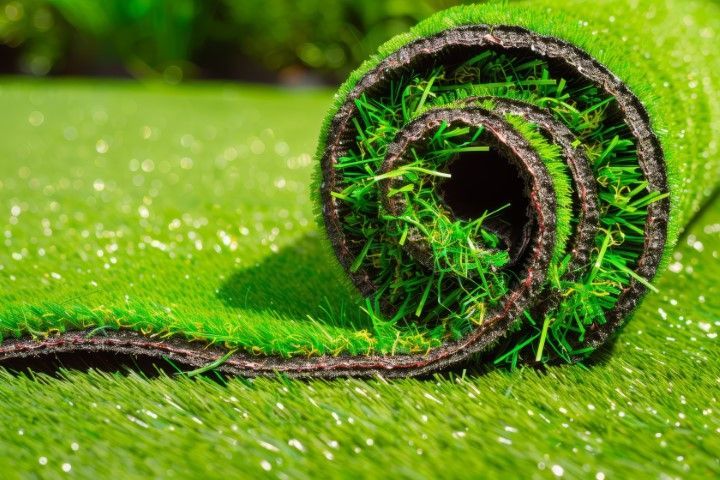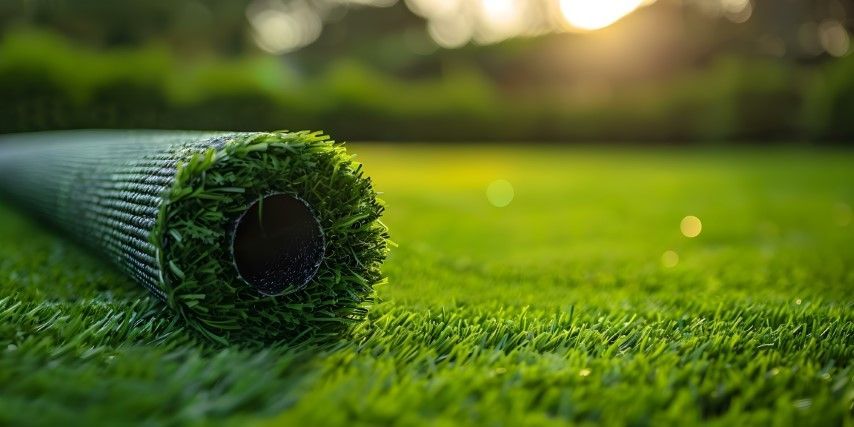Gold Coast Greenery Great Neck
516-202-0231
Infill Application on Long Island
Artificial grass has become a popular choice for homeowners and businesses alike due to its low maintenance, durability, and lush green appearance year-round. However, to ensure your artificial grass looks its best and performs optimally, proper infill installation on Long Island is essential. Infill is a crucial component of artificial grass systems, offering a range of benefits from stability to comfort and longevity. When installing artificial grass, choosing the right type of infill is key to ensuring it stays in top condition. Here are some of the most common types of infill materials used now:
Sand Infill
Sand is one of the most traditional and affordable infill options for artificial grass. It provides a solid base for the grass fibers, helping to weigh them down and keep them upright. Sand infill helps with drainage, making it a good choice for areas with heavy rainfall. While it’s a cost-effective option, it can be prone to compaction over time, which may reduce its effectiveness.
Rubber Infill
Made from recycled tires, rubber infill offers a cushioned feel, making it ideal for areas where safety and comfort are priorities, such as playgrounds or sports fields. Rubber infill improves shock absorption, reducing the impact of falls and offering a more natural feel underfoot. While it’s highly durable, it can sometimes retain heat in hot weather, which might make it less comfortable during the summer months.
Cork Infill
Cork is a natural, eco-friendly option that provides a soft, comfortable surface underfoot. It is lightweight and helps with drainage, similar to sand. Cork infill also has natural antimicrobial properties, reducing the growth of bacteria and mold in your artificial grass. It is a great choice for environmentally conscious homeowners who want a sustainable solution for their lawn.

Zeolite Infill
Zeolite is a mineral-based infill material known for its odor-reducing properties. It is commonly used in pet-friendly artificial grass installations to help eliminate odors caused by pet waste. Zeolite infill also aids in drainage and helps maintain the stability of the grass fibers. While it is more expensive than other types of infill, its odor control properties make it a great option for pet owners.
Hybrid Infill
Hybrid infill is a combination of different materials, often sand and rubber or sand and cork. This option combines the benefits of each material to create a balanced, high-performance infill system. Hybrid infill provides the stability and durability of sand, with the comfort and shock absorption of rubber or cork. It’s ideal for high-traffic areas where both durability and comfort are required.
Crumb Rubber
Infill Crumb rubber is made from finely shredded rubber and offers similar benefits to traditional rubber infill but with a finer texture. It provides superior cushioning and shock absorption, making it a popular choice for sports fields and playgrounds. Crumb rubber is also known for its durability and resilience, but like rubber infill, it can trap heat and may become hot under the sun.
Each type of infill has its advantages and is suitable for different applications. The right choice for your artificial grass depends on your needs, preferences, and budget. If you're looking for a natural and eco-friendly option, cork may be the best choice. For a more comfortable and cushioned feel, rubber or crumb rubber infill could be ideal. If odor control is important, zeolite infill will meet your needs.
Selecting the right infill for your artificial grass installation is essential to get the most out of your investment. We offer professional infill installation services on Long Island, NY, and will help you choose the best solution for your specific needs. Our experienced team ensures that your artificial grass remains vibrant, functional, and long-lasting. Ready to transform your lawn or landscape? Contact us now for a free consultation or to schedule your artificial grass installation with the perfect infill solution for you!

What Happens If You Don’t Use Turf Infill in Artificial Grass?
Artificial grass is an excellent choice for many homeowners and businesses looking for a low-maintenance, beautiful lawn that stays green year-round. While installing synthetic turf offers numerous benefits, many people overlook an essential component—turf infill. This special material plays a critical role in ensuring your artificial grass functions properly and lasts for years. Without turf infill, the performance and appearance of your lawn can suffer in a number of ways. Turf infill is designed to enhance the look, feel, and durability of artificial grass. It is typically made from materials like sand, rubber, or a combination of both. Here’s what can happen if you choose not to use it in your artificial grass installation:
Compromised Stability and Durability
One of the main reasons for using turf infill is to provide stability to the individual blades of grass. Without it, the fibers may shift, bend, or become matted over time, resulting in a flat, unnatural appearance. Additionally, without the added support of infill, the turf may wear down much quicker, especially in high-traffic areas.
Poor Drainage
Turf infill also helps with proper drainage. It allows water to flow through the turf more efficiently, preventing puddles from forming on the surface. Without infill, water may not drain properly, leading to pooling and soggy spots that can damage the turf and create a breeding ground for mold or mildew.
Uncomfortable Feel
Turf infill gives the artificial grass a more realistic feel. It fills in the gaps between the fibers, giving the surface a cushioned, soft texture that mimics the feel of natural grass. Without infill, the surface may feel hard and uncomfortable, making it less enjoyable to walk, play, or sit on.
Increased Wear and Tear
Turf that lacks infill can quickly start showing signs of wear and tear. Without the additional weight of infill, the fibers may not stay upright, resulting in a flatter appearance. This can make the grass look old and worn out much sooner, requiring more frequent maintenance or replacement.
Higher Maintenance Needs
Artificial grass with no infill tends to attract dirt, debris, and dust more easily. Without the protective layer of infill, it can become more difficult to keep the turf clean, and you may find yourself spending more time brushing, cleaning, and even replacing the turf.
Increased Heat Retention
Some types of turf infill, especially those made from organic materials, help regulate the temperature of your lawn by providing insulation. Without infill, the surface of your artificial grass can get much hotter in the sun, making it uncomfortable to walk on, especially during hot summer months.
If you’re considering installing artificial grass or need to learn more about the importance of turf infill and weed barrier setup, don’t hesitate to get in touch. Our team can guide you through the process, help you choose the best infill for your needs, and ensure your turf lasts for years to come. Contact us today to get started!

How Turf Infill Helps with Drainage and Stability in Artificial Lawns
Artificial lawns are a great alternative to natural grass, providing a lush, green look without the constant maintenance. However, achieving a functional and durable synthetic lawn requires more than just laying down the turf. Turf infill plays a crucial role in ensuring that your artificial lawn stays stable, drains efficiently, and maintains its appearance over time. Turf infill is a material placed between the fibers of artificial grass to provide weight, support, and enhance the performance of the lawn. Typically made from silica sand, rubber, or organic materials, turf infill is an essential component that offers several key benefits:
Improves Drainage
One of the most important roles of turf infill is to help with drainage. Artificial grass is designed with a permeable backing that allows water to flow through it. However, without infill, the turf fibers can collapse under pressure or become matted down, which can hinder the flow of water. Turf infill creates small gaps between the fibers, allowing water to drain more efficiently, preventing pooling and promoting faster drying.
Provides Stability and Cushioning
Turf infill helps maintain the stability of your artificial lawn by weighing down the turf, preventing it from shifting or lifting at the edges. It also ensures that the grass fibers stay upright, creating a more realistic look and feel. The added weight and cushioning provided by the infill allow for a softer, more comfortable surface, which is particularly beneficial in high-traffic areas or playgrounds.
Prevents Turf Movement
Infill stabilizes the synthetic fibers, keeping them in place. Without it, the grass fibers may move out of alignment, making the lawn look uneven and less appealing. The right amount of infill ensures that the grass blades remain in their intended position, maintaining the uniform appearance of your lawn. This is especially important for areas where pets, children, or foot traffic are frequent.
Helps Maintain Temperature
Certain types of turf infill, especially those made from rubber or organic materials, help moderate the temperature of the artificial grass. This can reduce the heat absorption that can sometimes cause synthetic lawns to become uncomfortably hot in the summer. The infill can act as an insulating layer, preventing excessive heating and ensuring that your artificial lawn remains comfortable and functional throughout the year.
If you’re looking to install or maintain an artificial lawn that is durable, stable, and drains effectively, don’t hesitate to contact us today. Our team can help you choose the right type of turf infill for your specific needs, ensuring your lawn looks great and performs well for years to come. Reach out to us now to learn more or to get started on your project!